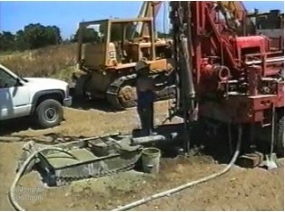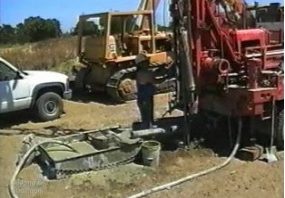
Subsurface Investigations— Geotechnical Site Characterization, May 2002
A couple of weeks ago, I was using a geotechnical report to develop a critical parameter for design of a particular foundation system. Like so many geotechnical reports I see, this report had many of the signs of being the product of commodity geotechnical services, as is often practiced when materials testing agencies offer geotechnical engineering. When geotechnical services are provided at the lowest possible cost, the effort to perform a subsurface exploration and provide a report must be reduced to the minimum, using the lowest-cost staff available. There is no budget for detailed analysis of data or development of site-specific recommendations by senior staff. The report is similar as to form as those provided a higher cost, but the substance and the level of service that produced it are not the same.
Interestingly, the services and reports provided by commodity geotechnical firms have a lot of the same short-comings. Perhaps this should not come as a surprise. To be competitive, these firms will have to use a lot of the same means to reduce the price of their services as similarly situated firms. This price competition on increasingly similar products and services is the essence of commoditization. Reaching the end of the process is to be a true commodity and be indistinguishable, except on price. While commodity geotechnical services are less expensive, they often increase cost overall by incentivizing excessive conservatism in design, leading to higher cost of construction and also by increasing uncertainty during construction, leading to higher risk of claims and delays.
Having had a lot of experience reading and using geotechnical reports, as well as experience producing them, the signs of commodity geotechnical services are quickly recognizable to me. They reflect a lack of thought and attention to detail in scoping the subsurface exploration, collection and presentation of data and development of recommendations. Here are a few common problems:
Inadequate exploration:
Deciding where to make borings and how deep they should go is always an exercise in balancing the cost of obtaining information and the value of that information to the project. As a general rule, borings should be located within, or at least near, the footprint of any proposed structures, and be advanced through any stratum that is to be subjected to significant loads. This requires some interaction with the design team to understand the proposed construction and how it will interface with the ground. Commodity firms will often “bid” on a scope provided by the structural engineer or architect, who may not know much about exploration methods and how to obtain the right information for a particular foundation system. Other times the geotechnical firm will propose a limited scope so as to compete with other firms on cost. Neither approach is conducive to obtaining the right information for efficient foundation design or for reliable construction costs estimates.
SPT Hammer Energy:
Standard Penetration Tests (SPTs) are still the most common geotechnical sampling and testing method. Because of the historical experience with SPTs, empirical correlations between SPT blow counts and other parameters are widely available, but a lot of them assume that the blow count produced using a hammer with a particular ratio of the actual to theoretical hammer energy. Modern automatic hammers are roughly 50 percent more efficient than traditional hammer and cathead systems. This requires a correction to be made to the field blow counts before using correlations. This correction cannot be made if the hammer type is not reported on the boring logs or in the report, yet a lot of firms, especially low-cost firms do not bother to do this. I am aware of at least one claim against a geotechnical firm for using uncorrected blow count obtained using an automatic hammer, resulting in a false-positive evaluation of liquefaction hazard.
Lack of Rock Sampling:
Since commodity geotechnical firms profit on production and volume, they typically do not want to sample rock. Rock coring is relatively time-consuming and can be difficult. As a result, they will forgo rock coring and report auger refusal as observations of the top of rock. The problem with this is that auger refusal does not always mean that rock is encountered. Sometimes refusal is the result of boulders or remnants of past structures. Also, characterizing the rock is often important. It is impossible to responsibly plan a rock excavation without rock sampling, yet it is relatively common for it to be omitted to reduce exploratory costs. A lot of claims are the result of mischaracterizing the top of rock or the condition of the rock.
It can be necessary to sample rock, even if there is no rock excavation. For example, in karst terrane, solution cavities result in settlement or sinkholes. It is therefore important to characterize the rock an check for voids near the surface. Yet, I was once involved in a project where there was known karst activity on the site and the geotechnical firm initially failed to sample the rock to see whether there were voids below the structure.
The subsurface exploration for my recent foundation design project included one core run in one boring, but that boring was located some distance away from structures that required rock excavation or deep foundation elements. In addition to this data being potentially unrepresentative, there were problems with the documentation, so that it was unclear what was actually observed. This leaves a lot of uncertainty for the foundation contractor and increases claims risk for the owner.
Inadequate or Incomplete Recommendations:
Developing project-specific design and construction recommendations requires thought and effort by experienced geotechnical and/or foundation engineers. This is a cost that commodity providers can afford with their extremely limit budgets. Commodity reports may be lengthy, but they tend to include a lot of copy-and-paste material from other reports. To be able to apply the same recommendations to many different projects with minimal changes requires them to be very conservative. For example, a lot of firms provide design parameters that are equal to lower-bound presumptive values found in the code. This results in costly pile foundations or ground improvement systems being used on sites where the soil has usable load bearing capacity.
In other cases, the recommendations are too vague. The report that I read for my recent project identified the necessity of the foundation system I was designing but provided no recommendations for design. This can lead to miscommunication between the geotechnical firm, the design team and the constructor. When a commodity firm encounters a project that is unusually complicated the recommendations may not be coordinated. For example, a soldier pile and lagging system might be called for in the excavation support recommendation, while the dewatering recommendations call for sheet piles. Finally, some firms will make grossly self-serving recommendations, like recommending foundations systems that they can install themselves.
Conclusion:
This list could go on and on. The point is that commodity geotechnical services have real shortcomings, which increase the overall cost and risk of a project. If the right data is not collected, or it is not sufficiently documented to allow proper interpretation, there is greater uncertainty about the subsurface conditions. Some of these uncertainties are known and can be managed by conservatism; that is the approach that commodity firms take to avoid being bankrupted by lawsuits. However, some uncertainties may not be discovered or fully evaluated and the resulting risks will be left unmanaged. Over-conservatism increases construction costs; unmanaged risk increases both the expected cost and the potential variability of the cost in a way that is difficult to estimate. This can threaten the viability of the project and the solvency of all involved.
It doesn’t have to be this way. The key is to implement a proactive risk management strategy for subsurface aspects of the project from the beginning. Then scope the subsurface exploration to obtain information that will better optimize design and reduce construction risk. There is nothing wrong with using a testing agency for laboratory testing or drilling and sampling, but a lot of projects will benefit from more project-specific engineering from before mobilizing the first drill rig through construction. Each piece of the geotechnical scope of services needs to be selected so as to provide benefit to the project. Obviously, this is easier to write than to do and there is an upfront cost, but the return on investment can be huge, especially if it prevents claims and protracted delays.
The information and statements in this document are for information purposes only and do not comprise the professional advice of the author or create a professional relationship between reader and author.
See also: Design Phase and Construction Phase Services, Foundation / Geostructural Engineering, Structural and Foundation Investigations
